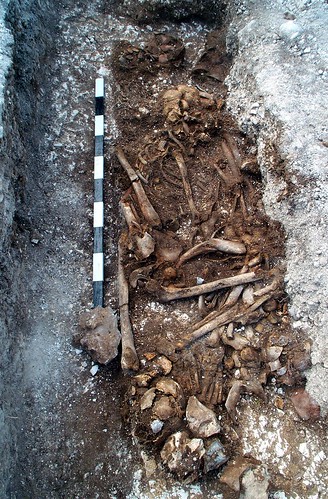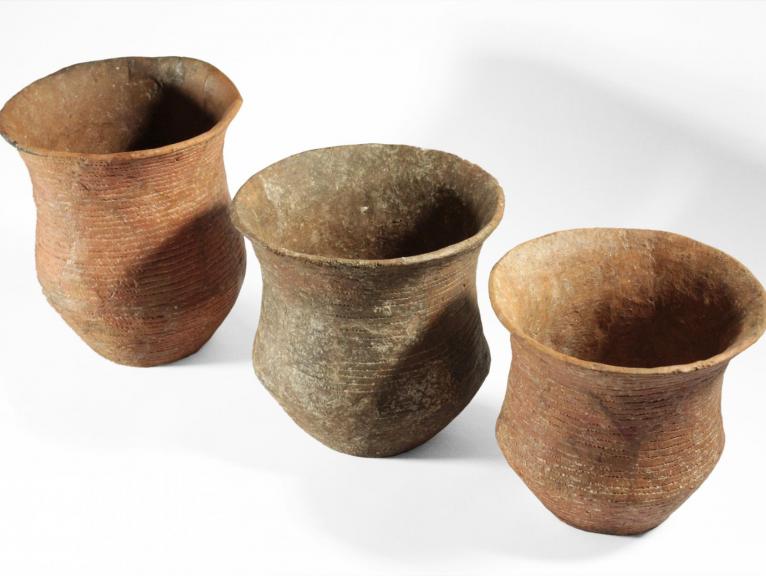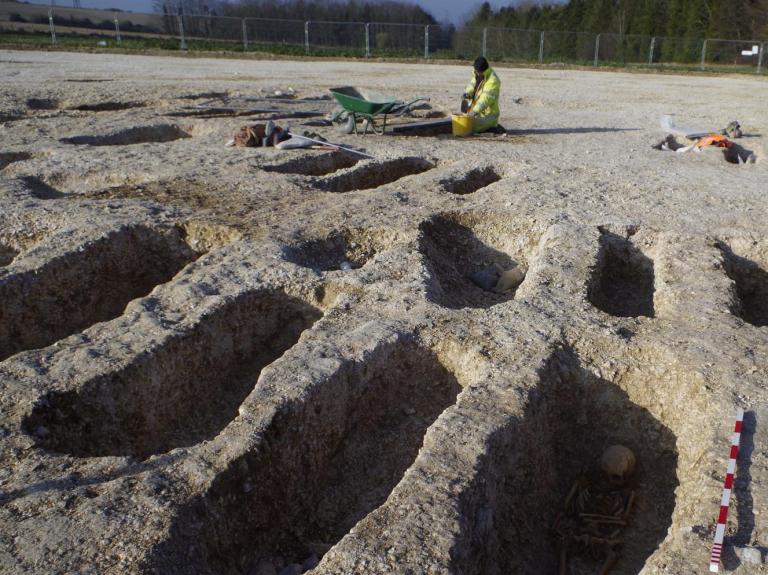The BBC Timewatch programme Stonehenge interprets the mysterious stone circles of Stonehenge as a temple built around 2,300 BC to which people came in search of healing. The Amesbury Archer is described as ‘one of most important archaeological discoveries in Britain.' He is called the Archer because of the stone arrowheads buried with him.
 This man, who lived between 2470-2280 BC, died not far from Stonehenge. By then he was between 35-45, but isotope fingerprinting of his teeth showed he was born far away, probably in the Alpine area of central Europe. Near to him lay the grave of a younger man who was a relative. This man, his ‘Companion,' had been brought up in not far from Stonehenge, but as a child he may have travelled, perhaps even to central Europe.
This man, who lived between 2470-2280 BC, died not far from Stonehenge. By then he was between 35-45, but isotope fingerprinting of his teeth showed he was born far away, probably in the Alpine area of central Europe. Near to him lay the grave of a younger man who was a relative. This man, his ‘Companion,' had been brought up in not far from Stonehenge, but as a child he may have travelled, perhaps even to central Europe.
Years before he died the Archer suffered a traumatic injury in which he lost his left knee and this led an infection of the wound that penetrated his very bones. He lived in constant pain from this wound, and as he put his weight on his good leg it grew stronger and the damaged leg withered. A tooth abscess also ruptured his jaw, and the infection that this caused may have led to his death.
The Timewatch programme argues that the stones brought from Wales to Stonehenge - the Bluestones - had healing powers. That is why, between 2,400 and 2,200 BC, they were carried over 150 miles, across land and over sea. Did the Amesbury Archer travel from near the Alps to Stonehenge motivated to find relief, to get better?

Perhaps the Archer sought magic. But he brought magic with him. In his grave was what at first sight looks like a small, black, stone. Its significance is that it was a metalworker's tool. And it identifies him as the oldest metalworker yet found in Britain. The gold hair ornaments buried with him are also the oldest gold objects yet found in Britain. The Amesbury Archer lived at the very beginning of the metal age in Britain.
Those skills had to be brought to Britain from across the Channel, carried by people like the Archer whose cultural links were with what archaeologists call the ‘Beaker culture'. These metalworkers had the practical skills in their hands and the knowledge of how to make metal objects in their heads.
Living at the beginning of the metal age, did the simple black stone eventually buried with the Archer give him a passport to travel through Europe? Was the status with which he was buried due to him having gained some relief from his illnesses at Stonehenge? Or was it, like many of the richest burials in continental Europe of this time, because of their new and seemingly magical skills in transforming stone to metal?
The Boscombe Bowmen: builders of Stonehenge?
Radiocarbon dates do not provide exact historical dates, like 1066. They are statements of the statistical probability of a date range. The date range of the burial of the Amesbury Archer overlaps with the initial interpretation of the new radiocarbon dates for the bluestone circle at Stonehenge, which are given as 2,400-2,200 BC.
Another very important ‘Beaker culture' grave, and which has a good match with the date range of 2,400-2,200 BC given in the programme for the first arrival of the bluestones at Stonehenge, is that of the Boscombe Bowmen. This grave, a simple grave cut into the chalk, was found 1km away from the graves of the Amesbury Archer and his Companion.
The grave of the Bowmen was different because it is a collective burial; it contains the remains of at least 7 people. Like the grave of the Archer, the Bowmen's grave also contained stone arrowheads and Beaker style pottery.
The way in which the Bowmen were buried is unusual for the time. Only parts of their skeletons were present, and before then these bones seem to have been buried elsewhere. It is difficult to find close parallels for this way of burial in Britain or elsewhere in Europe.
The isotope fingerprinting of the teeth of three of the young men buried in the grave showed that, like the Amesbury Archer, they were not local. One of the few places in Britain that matches the strontium and oxygen isotope fingerprints of the Bowmen is Wales.
The igneous rocks of Armorica in north-west France provide another possible origin, experts suggest. The strontium isotopes can be matched but the match for the oxygen isotopes is not as good. However, in Armorica it is not unusual for several ‘Beaker culture' burials to be found close by and it has been wondered if this is a more likely homeland for the Bowmen? In favour of this idea is that by shortly after 2,000 BC there were close links between Wessex and Armorica?
Against the idea is the view that although some burials in Armorica may be found close by, they were still the burials of individuals and not a collective grave. These burials were often placed in Stone Age megalithic tombs that were being re-used. In contrast, the Bowmen were buried in a simple grave cut into the chalk.
More important is the key scientific fact about the Boscombe Bowmen. This is that their isotopes show that they had migrated when they were children. They can be shown to have been in one place at about the age of 5 when their first permanent teeth grew, and in another at about the age of 12 when their last permanent teeth grew. Both places were different from the place they were buried as young men. This is the best isotope evidence for migration in prehistoric Europe.
Archaeologists and scientists cannot be sure of where the Boscombe Bowmen came from. But does the new dating of the bluestones at Stonehenge now suggest that Wales is the most likely homeland for the Bowmen? When they were children, did the Bowmen make a journey in which the adults who brought the bluestones from Wales to Stonehenge had led the way? Or like the Amesbury Archer, did they come from continental Europe? Were they pilgrims from France?






